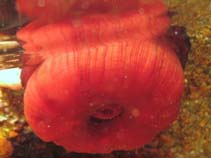Actinia equina (Linnaeus, 1758)
Beadlet anemoneWarning: DOMDocument::load(): SSL operation failed with code 1. OpenSSL Error messages: error:140770FC:SSL routines:SSL23_GET_SERVER_HELLO:unknown protocol in C:\Apache24\htdocs\includes\SpeciesSummary.lib.php on line 1236
Warning: DOMDocument::load(): Failed to enable crypto in C:\Apache24\htdocs\includes\SpeciesSummary.lib.php on line 1236
Warning: DOMDocument::load(https://sealifebase.nrm.se/webservice/AquaMaps/getAMap.php?genus=Actinia&species=equina): failed to open stream: operation failed in C:\Apache24\htdocs\includes\SpeciesSummary.lib.php on line 1236
Warning: DOMDocument::load(): I/O warning : failed to load external entity "https://sealifebase.nrm.se/webservice/AquaMaps/getAMap.php?genus=Actinia&species=equina" in C:\Apache24\htdocs\includes\SpeciesSummary.lib.php on line 1236
Classification / Names Common names | Synonyms | CoL | ITIS | WoRMS
| Actiniaria | Actiniidae
Environment: milieu / climate zone / depth range / distribution range Ekologi
; kisaran kedalaman 0 - 1600 m (Ref. 108103). Subtropical; 73°N - 36°S, 26°W - 143°E
Penyebaran Negara-negara | Daerah-daerah FAO | Ecosystems | Kemunculan | Introduksi
North and South Atlantic, Mediterranean and Pacific: From Atlantic Europe to northern Russia, the Mediterranan, South Africa and Japan.
Length at first maturity / Size / Weight / umur
Maturity: Lm ? range ? - ? cm Max length : 8.0 cm H jantan/; (Ref. 363)
Approximately 6 to 8 cm in height and less than 10 cm in diameter in extension (Ref. 363). Occurs at the water line, especially in sheltered places such as the inside of harbor walls (green Actinia), red Actinia can occasionally be encountered in the intertidal zone of Azores (Ref. 201)); Common run on the rocks, the surface to a few meters of depth (Ref. 363). Also found in infralittoral zones (Ref. 85338). Solitary (Ref. 2377).
Life cycle and mating behavior Kematangan | Reproduksi, perkembang biakan | Pemijahan | telur-telur | Fecundity | Larva
Members of the class Anthozoa are either gonochoric or hermaphroditic. Mature gametes are shed into the coelenteron and spawned through the mouth. Life cycle: The zygote develops into a planktonic planula larva. Metamorphosis begins with early morphogenesis of tentacles, septa and pharynx before larval settlement on the aboral end.
rujukan utama
Acuan | Koordinator | mitra
Wirtz, P., O. Ocaña and T. Molodtsova. 2003. (Ref. 201)
Status IUCN Red List (Ref. 130435)
status CITES (Ref. 108899)
Not Evaluated
CMS (Ref. 116361)
Not Evaluated
ancaman kepada manusia
penggunaan manusia
| FishSource |
Alat, peralatan
informasi lanjut
Nama-nama umum
Sinonim (persamaan)
Pemangsa
Reproduksi, perkembang biakan
Kematangan
Pemijahan
Fecundity
telur-telur
pekembangan telor
Sinonim (persamaan)
Pemangsa
Reproduksi, perkembang biakan
Kematangan
Pemijahan
Fecundity
telur-telur
pekembangan telor
Sumber internet
BHL | BOLD Systems | CISTI | DiscoverLife | FAO(Publication : search) | Fishipedia | GenBank (genom, Nukleotida) | GloBI | Gomexsi | Google Books | Google Scholar | Google | PubMed | Hexacorallians of the World | Tree of Life | Wikipedia (pergi, Cari) | Zoological Record
Estimates based on models
Preferred temperature
(Ref. 115969): 0.6 - 14.2, mean 7.8 (based on 456 cells).
kategori harga
(Ref. 80766):
Unknown.



